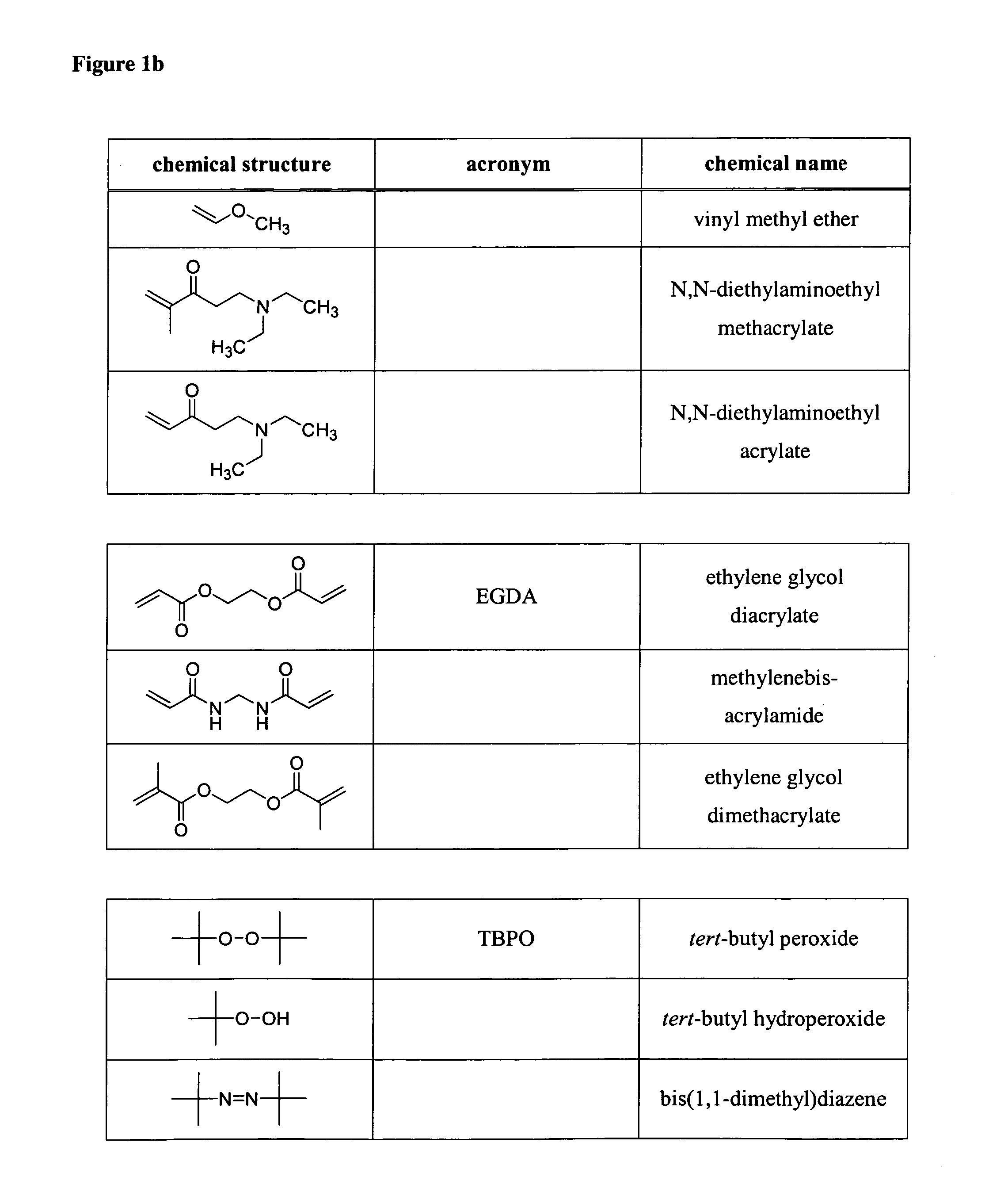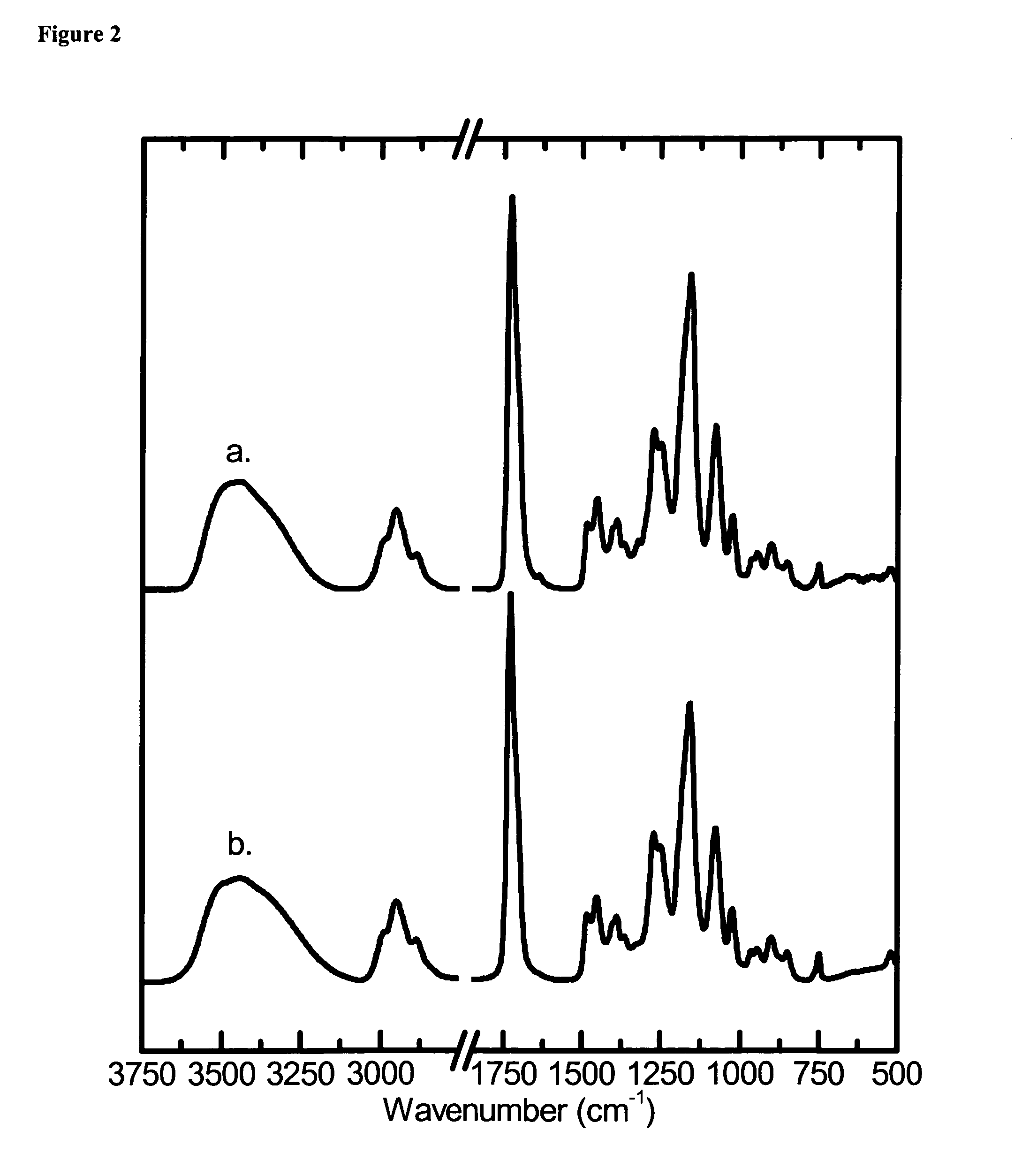Chemical vapor deposition of hydrogel films
a hydrogel film and chemical vapor technology, applied in chemical vapor deposition coatings, liquid surface applicators, coatings, etc., can solve the problems of limited bond-scission chemistry inside the chemical vapor deposition reactor, poor thickness control, and inability to demonstrate systematic control of crosslink density
- Summary
- Abstract
- Description
- Claims
- Application Information
AI Technical Summary
Benefits of technology
Problems solved by technology
Method used
Image
Examples
example 1
[0482] Materials and Methods.
[0483] Films were deposited on 100-mm-diameter silicon (Si) substrates in a custom-built vacuum reactor (Sharon Vacuum). The reactor was cylindrical with a height of 3.3 cm and a radius of 12 cm. The inlet of precursor gases and the exhaust were at opposite ends of the reactor. The top of the reactor was covered by a removable quartz plate (˜15 cm radius and 2.5 cm thick), allowing visual inspection, laser interferometry and placement of substrate. The reactor was equipped with a filament array, which provided thermal energy for selective decomposition of molecules, and a backside-cooled stage (35° C.) on which the substrate was placed. The clearance between the filaments and the stage was 29 mm. The Nichrome filaments (80% Ni / 20% Cr, AWG 26, Omega Engineering) were resistively heated to 280° C., as measured by a thermocouple (Type K, AWG 36, Omega Engineering) directly attached to one of them. The reactor pressure was maintained at 350 mTorr with a thr...
example 2a
[0485] Preparation of PHEMA-containing Films.
[0486] Two series of films were prepared. For the homopolymer experiments (linear PHEMA, denoted L1 to L5 in Table 3), no EGDA was introduced into the reactor.
TABLE 3Details of Experimental Runs (HEME / EGDA)Partial PressureFlow Rate (sccm)(mTorr)SampleHEMAEGDATBPON2HEMAEGDALinearSeriesL13.0—1.03.0150—L23.5—1.02.5175—L34.0—1.02.0200—L44.5—1.01.5225—L55.0—1.01.0250—Cross-linkedSeriesX14.00.01.02.02000X24.00.51.01.520025X34.01.01.01.020050X44.01.51.00.520075X54.02.01.00.0200100
[0487] The flow rate of HEMA was varied between 3 and 5 sccm in increments of 0.5 sccm, whereas that of TBPO was kept constant at 1 sccm. A patch flow of nitrogen was also introduced into the reactor to keep the total flow rate at 7 sccm. This arrangement ensured the same residence time of 5 s for all experimental runs. For the crosslinking experiments (crosslinked PHEMA, denoted X1 through X5 in Table 3), both the flow rates of HEMA (4 sccm) and TBPO (1 sccm) were k...
example 2b
[0488] Preparation of PVP-containing Films.
[0489] Two series of films were prepared. For the homopolymer experiments (linear PVP, denoted L6 to L10 in Table 4), no EGDA was introduced into the reactor.
TABLE 4Details of Experimental Runs (VP / EGDA)Partial PressureFlow Rate (sccm)(mTorr)SampleVPEGDATBPON2VPEGDALinear Series (500 mTorr)L67.0—1.02.0350.0—L76.5—1.02.5325.0—L86.0—1.03.0300.0—L95.5—1.03.5275.0—L105.0—1.04.0250.0—Cross-linked Series (420 mTorr)X610.00.01.01.0350.00.0X79.50.51.01.0332.517.5X89.01.01.01.0315.035.0X98.51.51.01.0297.552.5X108.02.01.01.0280.070.0
The flow rate of PVP was varied between 5 and 7 sccm in increments of 0.5 sccm, whereas that of TBPO was kept constant at 1 sccm. A patch flow of nitrogen was also introduced into the reactor to keep the total flow rate at 9 sccm. This arrangement ensured the same residence time for all experimental runs. For the crosslinking experiments (crosslinked PVP, denoted X6 through X10 in Table 4), flow rate of PVP was varied...
PUM
| Property | Measurement | Unit |
|---|---|---|
| temperatures | aaaaa | aaaaa |
| contact angle | aaaaa | aaaaa |
| temperature | aaaaa | aaaaa |
Abstract
Description
Claims
Application Information
 Login to View More
Login to View More - R&D
- Intellectual Property
- Life Sciences
- Materials
- Tech Scout
- Unparalleled Data Quality
- Higher Quality Content
- 60% Fewer Hallucinations
Browse by: Latest US Patents, China's latest patents, Technical Efficacy Thesaurus, Application Domain, Technology Topic, Popular Technical Reports.
© 2025 PatSnap. All rights reserved.Legal|Privacy policy|Modern Slavery Act Transparency Statement|Sitemap|About US| Contact US: help@patsnap.com



